动词不定式作宾语补足语、目的状语
- 格式:doc
- 大小:23.50 KB
- 文档页数:2
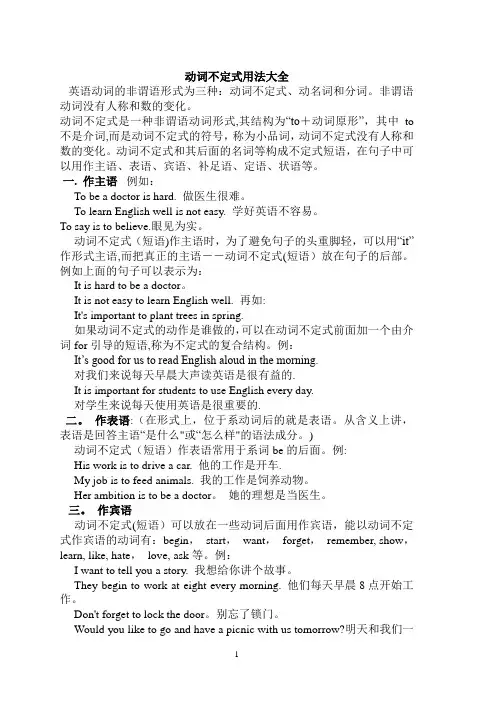
动词不定式用法大全英语动词的非谓语形式为三种:动词不定式、动名词和分词。
非谓语动词没有人称和数的变化。
动词不定式是一种非谓语动词形式,其结构为“to+动词原形”,其中to 不是介词,而是动词不定式的符号,称为小品词,动词不定式没有人称和数的变化。
动词不定式和其后面的名词等构成不定式短语,在句子中可以用作主语、表语、宾语、补足语、定语、状语等。
一. 作主语例如:To be a doctor is hard. 做医生很难。
To learn English well is not easy. 学好英语不容易。
To say is to believe.眼见为实。
动词不定式(短语)作主语时,为了避免句子的头重脚轻,可以用“it”作形式主语,而把真正的主语--动词不定式(短语)放在句子的后部。
例如上面的句子可以表示为:It is hard to be a doctor。
It is not easy to learn English well. 再如:It's important to plant trees in spring.如果动词不定式的动作是谁做的,可以在动词不定式前面加一个由介词for引导的短语,称为不定式的复合结构。
例:It’s good for us to read English aloud in the morning.对我们来说每天早晨大声读英语是很有益的.It is important for students to use English every day.对学生来说每天使用英语是很重要的.二。
作表语:(在形式上,位于系动词后的就是表语。
从含义上讲,表语是回答主语“是什么"或“怎么样"的语法成分。
)动词不定式(短语)作表语常用于系词be的后面。
例:His work is to drive a car. 他的工作是开车.My job is to feed animals. 我的工作是饲养动物。
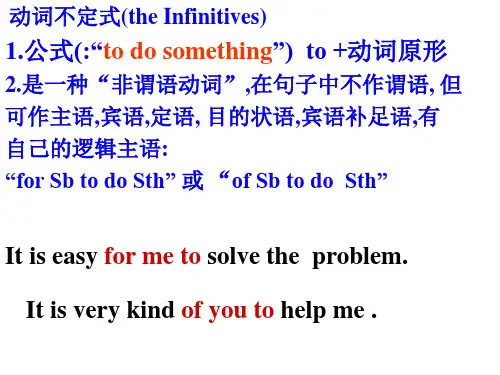
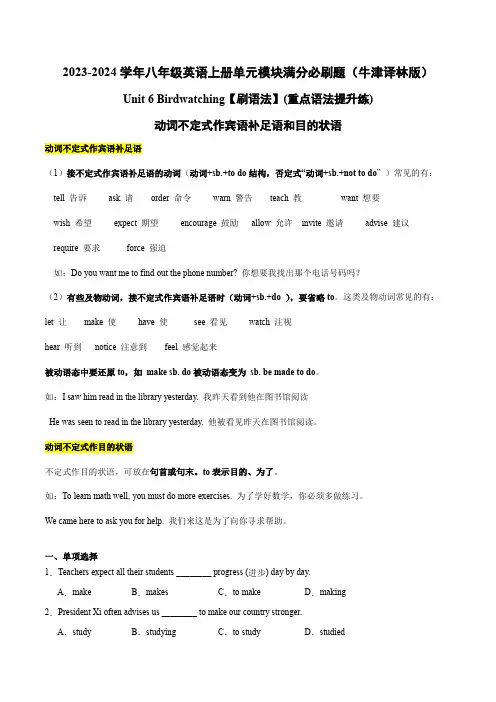
2023-2024学年八年级英语上册单元模块满分必刷题(牛津译林版)Unit 6 Birdwatching【刷语法】(重点语法提升练)动词不定式作宾语补足语和目的状语动词不定式作宾语补足语(1)接不定式作宾语补足语的动词(动词+sb.+to do结构,否定式“动词+sb.+not to do” )常见的有:tell 告诉ask 请order 命令warn 警告teach 教want 想要wish 希望expect 期望encourage 鼓励allow 允许invite 邀请advise 建议require 要求force 强迫如:Do you want me to find out the phone number? 你想要我找出那个电话号码吗?(2)有些及物动词,接不定式作宾语补足语时(动词+sb.+do ),要省略to。
这类及物动词常见的有:let 让make 使have 使see 看见watch 注视hear 听到notice 注意到feel 感觉起来被动语态中要还原to,如make sb. do被动语态变为sb. be made to do。
如:I saw him read in the library yesterday. 我昨天看到他在图书馆阅读He was seen to read in the library yesterday. 他被看见昨天在图书馆阅读。
动词不定式作目的状语不定式作目的状语,可放在句首或句末。
to表示目的、为了。
如:To learn math well, you must do more exercises. 为了学好数学,你必须多做练习。
We came here to ask you for help. 我们来这是为了向你寻求帮助。
一、单项选择1.Teachers expect all their students ________ progress (进步) day by day.A.make B.makes C.to make D.making2.President Xi often advises us ________ to make our country stronger.A.study B.studying C.to study D.studied3.—Our English teacher asks us ________ English every day.—So my mother made me ________ the English text for half an hour yesterday evening.A.read; to read B.to read; to read C.to read; read4.There are many rules in Mary’s home. Her parents won’t allow her ________ out late.A.to stay B.staying C.stay D.stayed5.I see Tom ________ English almost every morning.A.reads B.read C.reading D.to read 6.Teachers always encourage their students ________ questions and discuss the answers.A.answer B.answers C.answering D.to answer 7.The workers in the nature park ask visitors not ________ the animals.A.feed B.to feed C.feeding D.fed8.My mother asks me ________ computer games before finishing my homework.A.not play B.to play C.not to play D.to not play 9.Evans had a sore throat (嗓子疼). His friend advised him ________ a doctor.A.seeing B.to see C.see D.sees10.—The doctor advised me ________ too much because it’s not good for my health.—The doctor is right. The less you drink, ________ you will be.A.don’t drink; the healthier B.not to drink; the healthierC.not to drink; the more healthier D.don’t drink; healthier11.Mrs. Smith made her daughter ________ for a long time.A.wait B.waited C.to wait D.waiting12.The old lady loves to watch the kids ________ basketball every evening.A.play B.played C.to play D.plays13.Our teacher tells us ________ in the street. It’s too dangerous.A.not play B.not playing C.not to play D.to not play 14.— Why is Nancy crying?— Because her mother forces her ________ her teeth twice a day.A.brush B.brushing C.to brush D.brushed15.We don’t allow ________ in the classroom, but we allow students ________ in the hallways.A.to sing; to sing B.singing; to sing C.to sing; singing16.I advise you ________ twice before ________ final decision.A.thinking, to make B.to think, make C.thinking, made D.to think, making 17.Lin Tao is hard-working. I often see him ________ English. Yesterday afternoon, when I passed the playground, I saw him ________ soccer.A.read; playing B.reads; played C.to read; play D.be reading; play18.Our teacher often encourages us _______ our dreams no matter what will happen.A.to give up B.not to give up C.not give up D.not giving up19.The teacher advised students ________ to music when doing homework because it would distract (分散) their attention.A.listen B.to listen C.not to listen D.to not listen20.Tom challenged his friend ________ chess.A.play B.playing C.to play D.to playing21.—Can the shelf be finished by the weekend?—Sure. ________ it on time, we will work two more hours a day.A.Completed B.Completing C.To complete D.Complete22.—________ more about tomorrow’s weather in Sheyang, please call 121.—OK, I will. Thank you.A.Know B.Knowing C.To know D.To knowing23.—What way can you think of ________ me improve my listening?—By listening to the tape more.A.helping B.to help C.help24.________ their health, students should exercise more.A.Improve B.To improve C.Improving D.Improved25.Hunters hunt tigers ________ their fur ________ make clothes.A.to; to B.for; to C.to; for D.for; for26.________ the work in time, they need to work two more hours a day.A.To finish B.To be finished C.Finish D.Finishing27.We should do what we can ________ the hunters ________ the animals.A.to prevent; killing B.to prevent; to kill C.prevent; killing D.prevent; to kill 28.healthy, you should eat more vegetables and less fast food.A.Keep B.To keep C.Keeping D.Kept29.—If you need my help, please let me know. I will do anything I can ________ you.—No, thanks. I can do it all by myself.A.to support B.support C.supporting D.supported30.—Wild animals are in danger. They need more people’s help.— Yes. People working in the reserves are doing everything they can ________ them.A.protect B.protecting C.to protect D.to protecting31.________ before training, we all arrive early every time.A.Warm up B.Warming up C.To warm up D.Warmed up32.________ their products more easily, many farmers put them online.A.Sell B.Selling C.To sell D.To selling33.—Peter’s mother gets up early ______ breakfast for him every morning.—Mother’s love is great.A.to make B.making C.make34.President Xi Jinping delivers a New Year address on Saturday evening, Dec 31, 2022, in Beijing ______ 2023.A.welcome B.welcoming C.welcomed D.to welcome35.Susan made some more dumplings ________ her friend a treat during the Spring Festival.A.gives B.giving C.to give D.give36.Shall we go to Lao She Teahouse ________ Beijing Opera?A.to enjoy B.enjoy C.enjoyed D.enjoys37.I’m not good at English. I will work hard ______ it.A.to improve B.improve C.to correct D.correct38.You should practise ______ more in order to ______ your written English.A.to write;improving B.writing;improvingC.writing;improve D.to write;improve39.Last weekend Peter went to the library ________ some books on music.A.borrow B.borrowed C.to borrow D.borrowing40.He ran into the room ________ the girl.A.save B.to save C.saves D.saved二、用所给单词的正确形式填空41.He tried everything (start) the car, but he didn’t make it.42.The doctor did what he could (help) the girl who was badly hurt in the accident. 43.He started a blog (share)his knowledge and connect with like-minded individuals. 44.The teachers send emails (tell) students something on holidays.45.(keep) healthy, you should take more exercise.46.(make) the salad look more colourful, I often mix different fruits together.47.Look! The teenagers are making cards (show) love for their mothers.48.I made a lot of money (help) the poor.49.They decide to do something (protect) the animals.50.All doctors did what they could (save) the people after the earthquake.51.My little son fell in love with chess and often challenged me (play) chess with him. 52.Let’s (glue)these pictures on the big paper.53.Sally invited me (come) to the party, but I forgot it.54.The World Wide Fund for Nature (WWF) chose the panda (be) its symbol. 55.Could you tell my father (call) me when he comes back?56.We often hear some students (practice) speaking English in the English corner. 57.He warns Tom (not make) the same mistake again.58.I would like you (meet) a friend of mine.59.I would like to help people (solve) problems.60.He ordered his men (run) fast.参考答案:1.C【详解】句意:老师们希望所有的学生都能一天比一天进步。
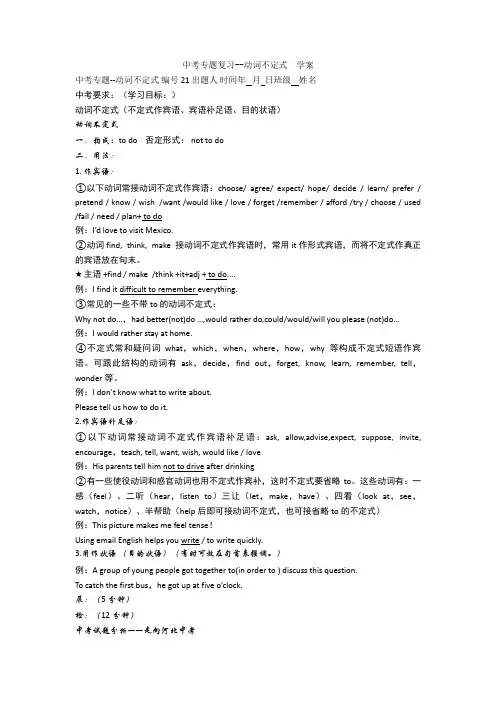
中考专题复习--动词不定式学案中考专题--动词不定式编号21 出题人时间年月日班级姓名中考要求:(学习目标:)动词不定式(不定式作宾语、宾语补足语、目的状语)动词不定式一.构成:to do 否定形式: not to do二.用法:1. 作宾语:①以下动词常接动词不定式作宾语:choose/ agree/ expect/ hope/ decide / learn/ prefer / pretend / know / wish /want /would like / love / forget /remember / afford /try / choose / used /fail / need / plan+ to do例:I’d love to visit Mexico.②动词find, think, make 接动词不定式作宾语时,常用it作形式宾语,而将不定式作真正的宾语放在句末。
★主语 +find / make /think +it+adj + to do....例:I find it difficult to remember everything.③常见的一些不带to 的动词不定式:Why not do…,had better(not)do …,would rather do,could/would/will you please (not)do…例:I would rather stay at home.④不定式常和疑问词what,which,when,where,how,why等构成不定式短语作宾语。
可跟此结构的动词有ask,decide,find out,forget, know, learn, remember, tell,wonder等。
例:I don’t know what to write about.Please tell us how to do it.2.作宾语补足语:①以下动词常接动词不定式作宾语补足语:ask, allow,advise,expect, suppose, invite, encourage,teach, tell, want, wish, would like / love例:His parents tell him not to drive after drinking②有一些使役动词和感官动词也用不定式作宾补,这时不定式要省略to。

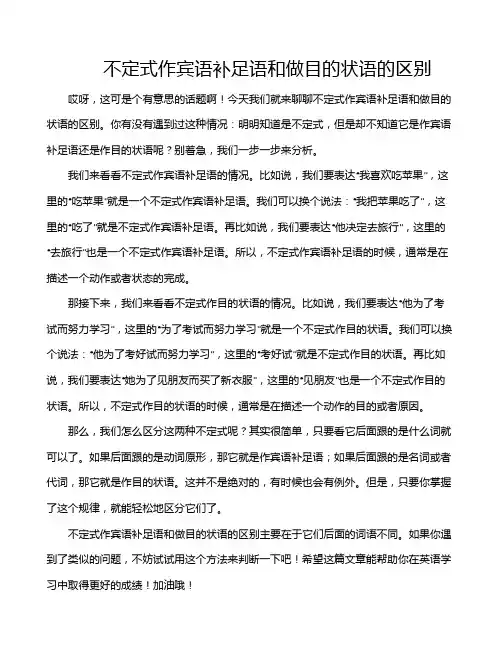
不定式作宾语补足语和做目的状语的区别哎呀,这可是个有意思的话题啊!今天我们就来聊聊不定式作宾语补足语和做目的状语的区别。
你有没有遇到过这种情况:明明知道是不定式,但是却不知道它是作宾语补足语还是作目的状语呢?别着急,我们一步一步来分析。
我们来看看不定式作宾语补足语的情况。
比如说,我们要表达“我喜欢吃苹果”,这里的“吃苹果”就是一个不定式作宾语补足语。
我们可以换个说法:“我把苹果吃了”,这里的“吃了”就是不定式作宾语补足语。
再比如说,我们要表达“他决定去旅行”,这里的“去旅行”也是一个不定式作宾语补足语。
所以,不定式作宾语补足语的时候,通常是在描述一个动作或者状态的完成。
那接下来,我们来看看不定式作目的状语的情况。
比如说,我们要表达“他为了考试而努力学习”,这里的“为了考试而努力学习”就是一个不定式作目的状语。
我们可以换个说法:“他为了考好试而努力学习”,这里的“考好试”就是不定式作目的状语。
再比如说,我们要表达“她为了见朋友而买了新衣服”,这里的“见朋友”也是一个不定式作目的状语。
所以,不定式作目的状语的时候,通常是在描述一个动作的目的或者原因。
那么,我们怎么区分这两种不定式呢?其实很简单,只要看它后面跟的是什么词就可以了。
如果后面跟的是动词原形,那它就是作宾语补足语;如果后面跟的是名词或者代词,那它就是作目的状语。
这并不是绝对的,有时候也会有例外。
但是,只要你掌握了这个规律,就能轻松地区分它们了。
不定式作宾语补足语和做目的状语的区别主要在于它们后面的词语不同。
如果你遇到了类似的问题,不妨试试用这个方法来判断一下吧!希望这篇文章能帮助你在英语学习中取得更好的成绩!加油哦!。
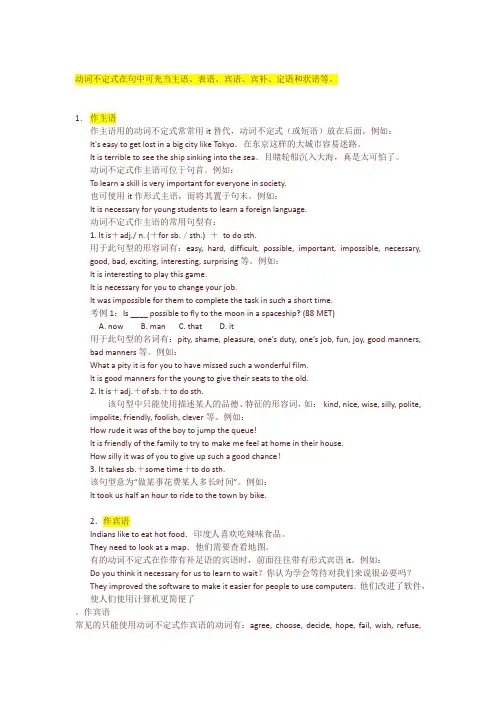
动词不定式在句中可充当主语、表语、宾语、宾补、定语和状语等。
1.作主语作主语用的动词不定式常常用it替代,动词不定式(或短语)放在后面。
例如:It's easy to get lost in a big city like Tokyo.在东京这样的大城市容易迷路。
It is terrible to see the ship sinking into the sea.目睹轮船沉入大海,真是太可怕了。
动词不定式作主语可位于句首。
例如:To learn a skill is very important for everyone in society.也可使用it作形式主语,而将其置于句末。
例如:It is necessary for young students to learn a foreign language.动词不定式作主语的常用句型有:1. It is+adj./ n. (+for sb./sth.) +to do sth.用于此句型的形容词有:easy, hard, difficult, possible, important, impossible, necessary, good, bad, exciting, interesting, surprising等。
例如:It is interesting to play this game.It is necessary for you to change your job.It was impossible for them to complete the task in such a short time.考例1:Is ____ possible to fly to the moon in a spaceship? (88 MET)A. nowB. manC. thatD. it用于此句型的名词有:pity, shame, pleasure, one’s duty, one’s job, fun, joy, good manners, bad manners等。
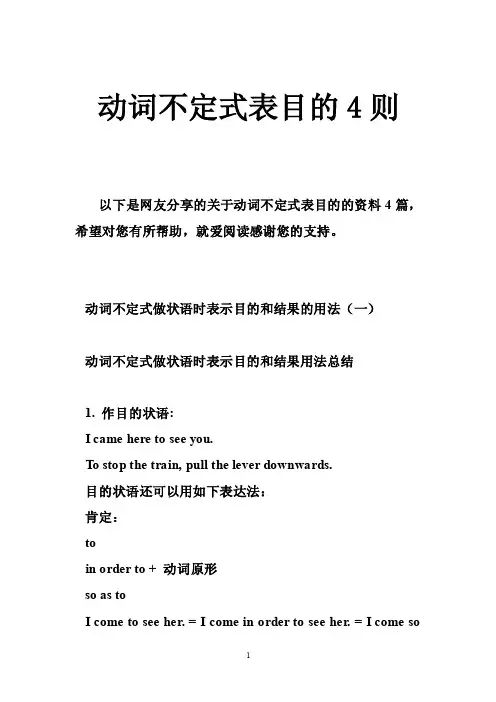
动词不定式表目的4则以下是网友分享的关于动词不定式表目的的资料4篇,希望对您有所帮助,就爱阅读感谢您的支持。
动词不定式做状语时表示目的和结果的用法(一)动词不定式做状语时表示目的和结果用法总结1. 作目的状语:I came here to see you.T o stop the train, pull the lever downwards.目的状语还可以用如下表达法:肯定:toin order to + 动词原形so as toI come to see her. = I come in order to see her. = I come soas to see her.thatso that + 主语+ may/might + 动词原形I come that I may see her. = I come in order that I may see her. = I come so that I may see her.否定:not toin order not to + 动词原形so as not tothatso that + 主语+ may/might ++ 动词原形in order thatHe went away not to see me.= He went away in order not to see me.= He went away so as not to see me.= He went away in order that he might not see me.= He went away that he might not see me.= He went away so that he might not see me.in order to, in order that和so as to, so that的区别in order to可以用在句首或句末,但so as to只能用在句末。
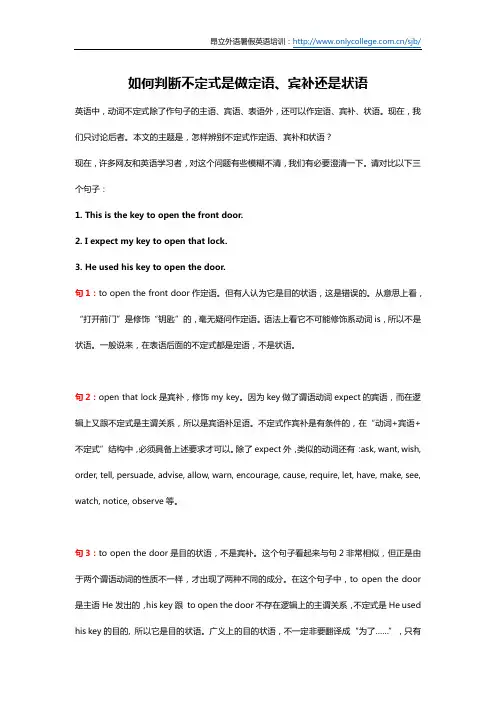
如何判断不定式是做定语、宾补还是状语英语中,动词不定式除了作句子的主语、宾语、表语外,还可以作定语、宾补、状语。
现在,我们只讨论后者。
本文的主题是,怎样辨别不定式作定语、宾补和状语?现在,许多网友和英语学习者,对这个问题有些模糊不清,我们有必要澄清一下。
请对比以下三个句子:1. This is the key to open the front door.2. I expect my key to open that lock.3. He used his key to open the door.句1:to open the front door作定语。
但有人认为它是目的状语,这是错误的。
从意思上看,“打开前门”是修饰“钥匙”的,毫无疑问作定语。
语法上看它不可能修饰系动词is,所以不是状语。
一般说来,在表语后面的不定式都是定语,不是状语。
句2:open that lock是宾补,修饰my key。
因为key做了谓语动词expect的宾语,而在逻辑上又跟不定式是主谓关系,所以是宾语补足语。
不定式作宾补是有条件的,在“动词+宾语+不定式”结构中,必须具备上述要求才可以。
除了expect外,类似的动词还有:ask, want, wish, order, tell, persuade, advise, allow, warn, encourage, cause, require, let, have, make, see, watch, notice, observe等。
句3:to open the door是目的状语,不是宾补。
这个句子看起来与句2非常相似,但正是由于两个谓语动词的性质不一样,才出现了两种不同的成分。
在这个句子中,to open the door 是主语He发出的,his key跟to open the door不存在逻辑上的主谓关系,不定式是He used his key的目的, 所以它是目的状语。
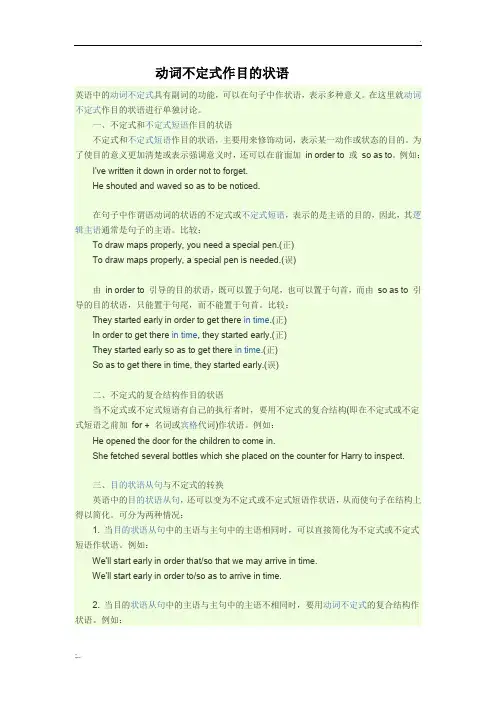
动词不定式作目的状语英语中的动词不定式具有副词的功能,可以在句子中作状语,表示多种意义。
在这里就动词不定式作目的状语进行单独讨论。
一、不定式和不定式短语作目的状语不定式和不定式短语作目的状语,主要用来修饰动词,表示某一动作或状态的目的。
为了使目的意义更加清楚或表示强调意义时,还可以在前面加in order to 或so as to。
例如:I've written it down in order not to forget.He shouted and waved so as to be noticed.在句子中作谓语动词的状语的不定式或不定式短语,表示的是主语的目的,因此,其逻辑主语通常是句子的主语。
比较:To draw maps properly, you need a special pen.(正)To draw maps properly, a special pen is needed.(误)由in order to 引导的目的状语,既可以置于句尾,也可以置于句首,而由so as to 引导的目的状语,只能置于句尾,而不能置于句首。
比较:They started early in order to get there in time.(正)In order to get there in time, they started early.(正)They started early so as to get there in time.(正)So as to get there in time, they started early.(误)二、不定式的复合结构作目的状语当不定式或不定式短语有自己的执行者时,要用不定式的复合结构(即在不定式或不定式短语之前加for + 名词或宾格代词)作状语。
例如:He opened the door for the children to come in.She fetched several bottles which she placed on the counter for Harry to inspect.三、目的状语从句与不定式的转换英语中的目的状语从句,还可以变为不定式或不定式短语作状语,从而使句子在结构上得以简化。
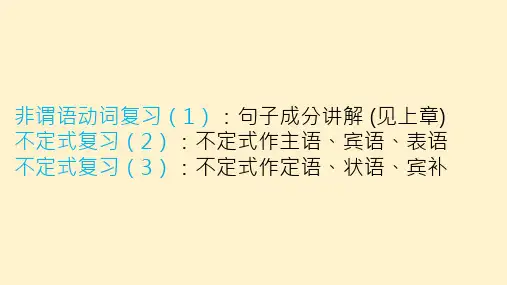
====Word行业资料分享--可编辑版本--双击可删====怎么区别不定式作为宾补还是状语呀?这两种都是把动词不定时放于动词之后。
这个动词就很关键了,如果是及物动词,后边可以带宾语,如ask/like/teach/tell/help+to do sth.则动词不定式是做的宾语补足语。
第二种情况是放在不及物动词之后,如go/com/stop+to do sth.则应该翻译为状语,一般为地点状语。
ONE:宾语表示动作行为的对象,跟在及物动词之后,能作宾语的有名词,代词,数词,动词不定式等。
We like Eng'lish.我们喜欢英语。
注意看你翻译出句子后,它是做的动作的对象内容,还是只是表明地点、时间、原因、目的、结果、条件、方向、程度、方式和伴随状况等。
TWOask/like/teach/tell/help+to do sth,里面的动词后面可以跟宾语,我们称作及物动词。
例如,Father often tells me to study hard(爸爸经常告诉我要努力学习)。
第一点,这个句子中的谓语动词是tell(告诉),后边就可以直接跟宾语,如Please tell me the truth(请告诉我真相),第二点,这个句子里me做的是直接宾语,也就是告诉的对象,而to study hard做的是宾语补足语,也就是告诉的内容。
go/come/stop+to do sth则应该翻译为状语THREE第一,这些词后边不能带宾语的。
例如,Lily goes to school every morning.(lily每天早晨去上学)这里的to school 就是表明地点的地点状语,而不是宾语,也就是动作的承受者了。
第二,英语中,修饰动词、形容词、副词等的句子成分叫状语(adverbial)。
状语的功用:状语说明地点、时间、原因、目的、结果、条件、方向、程度、方式和伴随状况等。
不定式在句子中可以作目的状语。
不定式作宾语补足语和做目的状语的区别下载提示:该文档是本店铺精心编制而成的,希望大家下载后,能够帮助大家解决实际问题。
文档下载后可定制修改,请根据实际需要进行调整和使用,谢谢!本店铺为大家提供各种类型的实用资料,如教育随笔、日记赏析、句子摘抄、古诗大全、经典美文、话题作文、工作总结、词语解析、文案摘录、其他资料等等,想了解不同资料格式和写法,敬请关注!Download tips: This document is carefully compiled by this editor. I hope that after you download it, it can help you solve practical problems. The document can be customized and modified after downloading, please adjust and use it according to actual needs, thank you! In addition, this shop provides you with various types of practical materials, such as educational essays, diary appreciation, sentence excerpts, ancient poems, classic articles, topic composition, work summary, word parsing, copy excerpts, other materials and so on, want to know different data formats and writing methods, please pay attention!不定式作宾语补足语和做目的状语的区别在学习中文语法时,不定式作为宾语补足语和目的状语是两个常见的用法,它们虽然都涉及到不定式的使用,但其作用和结构有着明显的区别。
不定式作宾语补足语和做目的状语的区别哎呀,今天我们来聊聊一个很有趣的话题:不定式作宾语补足语和做目的状语的区别。
你们知道吗?不定式可是英语里非常重要的一个词性,它既可以作宾语补足语,也可以作目的状语。
不过,它们之间还是有区别的哦!让我们一起来揭开这个谜底吧!我们来说说不定式作宾语补足语。
你们知道什么是宾语补足语吗?简单来说,就是一个动词后面的那个“什么”,用来补充说明这个动作的对象或者状态。
比如说,我们经常说:“我吃了一个苹果。
”,这里的“一个苹果”就是“吃”的宾语补足语。
而不定式作宾语补足语的时候,就是在动词后面加上一个“to do”的形式,比如“I like to eat an apple.”。
这样一来,整个句子就变得非常通顺了,意思也更加明确。
那么,不定式作目的状语又是什么呢?目的状语就是表示一个动作的目的或者原因。
比如说,我们经常说:“我去学校是为了学习。
”,这里的“为了学习”就是目的状语。
而不定式作目的状语的时候,就是在动词前面加上一个“in order to”,比如“I go to school in order to study.”。
这样一来,整个句子就变得更加生动有趣了,让人感觉好像在看一部电影一样。
好了,现在我们已经知道了不定式作宾语补足语和做目的状语的区别,接下来我们就要用实际的例子来进行练习了。
我们来看一下不定式作宾语补足语的例子:“我吃了一碗面条。
”,这里的“一碗面条”就是“吃”的宾语补足语。
然后,我们再来看一下不定式作目的状语的例子:“我去看电影是为了放松心情。
”,这里的“为了放松心情”就是目的状语。
当然啦,不定式作宾语补足语和做目的状语的用法还有很多很多,这里只是给大家提供一个简单的参考。
希望大家在以后的学习中能够更加熟练地运用不定式哦!我想说的是,英语学习并不是一件容易的事情,但是只要我们用心去学,一定能够取得好成绩的。
所以呢,大家要加油哦!。
不定式作宾语补足语和做目的状语的区别哎呀,今天咱们来聊聊一个有趣的话题:不定式作宾语补足语和做目的状语的区别。
你可能会想,这有什么好聊的呢?不就是动词后面的两个小东西嘛!别急,听我给你慢慢道来。
咱们来聊聊不定式作宾语补足语。
啥叫宾语补足语呢?简单来说,就是一个动词后面跟着一个形容词或者名词,表示这个动作的对象或者结果。
比如,我喜欢吃苹果(吃是动词,苹果是宾语补足语)。
你可能会觉得,这不就是动宾结构吗?其实,不定式作宾语补足语还有一个特点,那就是它可以省略“to”。
比如,我喜欢吃苹果(省略了to),你可能会说,这不就是动宾结构吗?其实,这就是不定式作宾语补足语。
那么,不定式作宾语补足语和做目的状语有什么区别呢?别看它们都是在动词后面加一个小东西,但是它们的作用可是大不一样的哦!做目的状语的意思是,说明一个动作的目的或者原因。
比如,我去看电影(看电影是目的状语),就是为了放松一下。
而不定式作宾语补足语的意思则是,说明一个动作的对象或者结果。
比如,我喜欢吃苹果(吃苹果是宾语补足语),就是因为它好吃。
现在,让我给你举几个例子,看看这两个小东西是怎么发挥作用的吧!例一:他学习很努力(不定式作宾语补足语)这个人学习很努力,也就是说他学习的结果是很努力的。
这里的“努力”就是不定式作宾语补足语。
你看,这个例子里面就用到了“努力”这个形容词作为宾语补足语。
例二:我去图书馆借书(不定式作目的状语)我去图书馆借书,是为了准备考试。
这里的“为了准备考试”就是不定式作目的状语。
你看,这个例子里面就用到了“准备考试”这个名词作为目的状语。
通过这两个例子,你应该明白不定式作宾语补足语和做目的状语的区别了吧!这只是冰山一角,实际上还有很多很多的例子等着你去发现。
所以,以后可不要小看那些看似不起眼的小东西哦!它们有时候可是能发挥大作用的!不定式作宾语补足语和做目的状语虽然都是在动词后面加一个小东西,但是它们的作用却是大相径庭的。
to 宾补目的状语定语后置
这是一个比较常见的汉语语法结构。
具体来说:
1. to 宾补:这个结构中,“to”后面跟的一般是动词不定式,
这个动词不定式在句子中作为宾语补足语。
例如,“I want to eat pizza.” 中的“to eat pizza”就是“want”的宾语补足语。
2. 目的状语:这个结构通常是为了表达某个行为的目的而设置的,这个目的状语放在整个句子的末尾。
例如,“I went to the store
to buy some milk.” 中的“to buy some milk”就是目的状语。
3. 定语后置:在这个结构中,定语通常放在名词或者代词的后面。
例如,“the boy who is wearing a blue shirt”中的“who is wearing a blue shirt”就是后置定语。
因此,当结合这三种语法结构时,我们可以得到一个句子的基本
结构为:
主语 + 谓语 + 宾补 + 目的状语 + 后置定语
例如,“He wants to buy a new car to drive to work.” 中,“he”是主语,“wants to buy a new car”是谓语,“to drive to work”是目的状语,“a new car”是宾语,后置定语没有出现在这个
句子里面。
初中英语中的动词不定式动词不定式作在句中可以充当主语、宾语、宾语补足语、目的状语等。
1.动词不定式作宾语当句了中已经有谓语动词,而我们又要表达不止一个动作概念时,其它的动词可以使用非谓语形式表达。
动词不定式就是动词的种非谓语形式,其基本形式是“to + 动词原形”。
如:He wants to play football after class,他想课后瑞足球.Remember to turn off the light when you leave the romm. 记住离开房间时把关灯了。
注意:动词不定式在句子中不作谓语,因此没有人称、数和时态的变化。
动词不定式在句中常作谓语动词的宾语,这一类谓语动词常见的有:agree(同意),choose(选择),decide(决定),forget(忘记),hope(希望),learn(学习),ike(喜欢),plan(计划),prepare(准备),promise(答应),refuse(拒绝),remember(i记得),seem(觉得好像),want(想要),wish(希望),would like(想要)。
我们可以这样来记忆,choose to do something,decide to do something等。
She decided to visit her grandparents this weekend.她决定这个周未去看望她的祖父母。
注意:动词不定式的否定形式是“not to + 动词原形”。
如:You must promise not to be late again.你必须保证不再迟到了。
2.疑问词+ 动词不定式我们可以用“疑问词+ 动词不定式”结构作动词的宾语。
疑问词包括疑问代词wht、which、who和疑问副词how、when、where等。
常和“疑问词+ 动词不定式”结构连用的动词及动词短语有:know、learn、see、hear、ask、tell、advise、decide、explain、find out、forget、remember、think、understand、wonder等。
一.动词不定式作宾语补足语
1.because i t allows people to get closer to them. 因为它允许
你们更近距离的接触它们。
Allow是动词,people 是宾语to get closer to them 作宾语people的补足语
2.the world wide fund for nature chose the panda to be its
symbol. 世界自然基金会选择了大熊猫作为其标志。
Choose----chose 是动词,the panda 是宾语to be its symbol 作宾语补足语
3.ask sb to do sth 让某人做某事tell sb to do sth 告诉某人
做某事invite sb to do sth 邀请某人做某事help sb to do sth 帮助某人做某事want sb to do sth 想要某人做某事allow sb to do sth 允许某人做某事
4.tell sb not do sth 告诉某人不要做某事my teacher tells
us not to make too much noise. 我的老师告诉我们不要弄出太大声音。
My friend invites me to his home. 我的朋友邀请我去他的家里。
5.help/let/make sb do sth 帮助某人做某事/让某人做某事his words makes everyone laugh. 他的话让每个人都笑了
she helps me do my homework. 她帮助我做作业
二.动词不定式作目的状语:做某事是为了什么.
1.the wwf is working hard to save them all. 世界自然基金会
正在努力挽救所有的动物。
To save them all 是目的状语2.dylan trained hard to improve his basketball skills. 迪伦刻苦
训练一提高自己的篮球技能。
3.to improve his basketball skills, dylan trained hard.。